How Can the Blue Economy Contribute to Inclusive Growth and Ecosystem Resources in Asia? A Comparative Analysis
Abstract
:1. Introduction
2. Literature Review
3. Materials and Methods
3.1. Justification of Independent Variables
3.2. Econometric Methods
3.2.1. Panel Heteroscedasticity Test
3.2.2. Panel Autocorrelation Test
3.2.3. Panel Unit Root (CIPS) Test
3.2.4. Panel Cointegration Test of Westerlund
3.2.5. Long-Run Estimation Method
4. Results
4.1. Descriptive Analysis
4.2. Preliminary Tests
4.3. Regression Results
5. Discussion
6. Conclusions
Author Contributions
Funding
Informed Consent Statement
Data Availability Statement
Conflicts of Interest
Nomenclature
| (IG) | Inclusive Growthgrowth |
| (FP) | Fishery Productionproduction |
| (AP) | Aquaculture Productionproduction |
| (AFF) | Agriculture, Forestryforestry, and Fishingfishing |
| (CL) | Capital Labour–labor |
| (TO) | Trade Opennessopenness |
| (EF) | Ecological Footprintfootprint |
| (REU) | Renewable Energy Utilizationenergy utilization |
References
- Bunyavejchewin, P.; Nimmannorrawong, P. The asia cooperation dialogue (acd): Formation and development. Ritsumeikan J. Asia Pac. Stud. 2017, 35, 18–29. [Google Scholar]
- Brennig, J.J. The Textile Trade of Seventeenth-Century Northern Coromandel: A Study of a Pre-Modern Asian Export Industry; The University of Wisconsin-Madison: Madison, WI, USA, 1975. [Google Scholar]
- Fleming, L.E.; Maycock, B.; White, M.P.; Depledge, M.H. Fostering human health through ocean sustainability in the 21st century. People Nat. 2019, 1, 276–283. [Google Scholar] [CrossRef]
- Frierson, P. The Last Atoll: Exploring Hawaii’s Endangered Ecosystems; Trinity University Press: San Antonio, TX, USA, 2012. [Google Scholar]
- Burkett, V.; Davidson, M. Coastal Impacts, Adaptation, and Vulnerabilities; Springer: Cham, Switzerland, 2012. [Google Scholar]
- Ntona, M.; Morgera, E. Connecting SDG 14 with the other Sustainable Development Goals through marine spatial planning. Mar. Policy 2018, 93, 214–222. [Google Scholar] [CrossRef]
- Cichowicz, E.; Rollnik-Sadowska, E. Inclusive growth in CEE countries as a determinant of sustainable development. Sustainability 2018, 10, 3973. [Google Scholar] [CrossRef]
- Hampton, M.P.; Jeyacheya, J.; Long, P.H. Can tourism promote inclusive growth? Supply chains, ownership and employment in Ha Long Bay, Vietnam. J. Dev. Stud. 2018, 54, 359–376. [Google Scholar] [CrossRef]
- Rouzet, D.; Sánchez, A.C.; Renault, T.; Roehn, O. Fiscal Challenges and Inclusive Growth in Ageing Societies; OECD: Paris, France, 2019. [Google Scholar]
- Mirzoev, T.; Tull, K.I.; Winn, N.; Mir, G.; King, N.V.; Wright, J.M.; Gong, Y.Y. Systematic review of the role of social inclusion within sustainable urban developments. Int. J. Sustain. Dev. World Ecol. 2022, 29, 3–17. [Google Scholar] [CrossRef]
- Aldaco, R.; Ruiz, I.; Margallo, M.; Laso, J.; Hoehn, D. Deliverable Title: D4. 1.1 State of the Art Report of the Seafood Sector in the European Atlantic Area. 2020. Available online: https://neptunus-project.eu/wp-content/uploads/2021/05/D4.1.1-Report-Neptunus-State-of-the-art.pdf (accessed on 31 October 2023).
- Naylor, R.L.; Hardy, R.W.; Buschmann, A.H.; Bush, S.R.; Cao, L.; Klinger, D.H.; Little, D.C.; Lubchenco, J.; Shumway, S.E.; Troell, M. A 20-year retrospective review of global aquaculture. Nature 2021, 591, 551–563. [Google Scholar] [CrossRef]
- Valenti, W.C.; Kimpara, J.M.; Preto, B.d.L.; Moraes-Valenti, P. Indicators of sustainability to assess aquaculture systems. Ecol. Indic. 2018, 88, 402–413. [Google Scholar] [CrossRef]
- Picatoste, X.; Novo-Corti, I.; Tirca, D.M. Human Development Index as an Indicator of Social Welfare. In No Poverty; Springer: Cham, Switzerland, 2021; pp. 449–459. [Google Scholar]
- Ojea, E.; Lester, S.E.; Salgueiro-Otero, D. Adaptation of fishing communities to climate-driven shifts in target species. One Earth 2020, 2, 544–556. [Google Scholar] [CrossRef]
- Ouattara, N.; Zeufack, A.G. Unlocking East Asian Markets to Sub-Saharan Africa. In Africa in the New Trade Environment Market Access in Troubled Times; World Bank: Washington, DC, USA, 2022; pp. 135–185. [Google Scholar]
- Batrancea, L.M.; Rathnaswamy, M.M.; Rus, M.-I.; Tulai, H. Determinants of economic growth for the last half of century: A panel data analysis on 50 countries. J. Knowl. Econ. 2022, 14, 2578–2602. [Google Scholar] [CrossRef]
- Kremen, C.; Merenlender, A.M. Landscapes that work for biodiversity and people. Science 2018, 362, eaau6020. [Google Scholar] [CrossRef] [PubMed]
- Mansour, S.; Al-Awadhi, T.; Al Nasiri, N.; Al Balushi, A. Modernization and female labour force participation in Oman: Spatial modelling of local variations. Ann. GIS 2022, 28, 229–243. [Google Scholar] [CrossRef]
- Lee, J.W. Convergence success and the middle-income trap. Dev. Econ. 2020, 58, 30–62. [Google Scholar] [CrossRef]
- Sanguinetti, P.; Moncarz, P.; Vaillant, M.; Allub, L.; Juncosa, F.; Barril, D.; Cont, W.; Lalanne, Á. Pathways to Integration: Trade Facilitation, Infrastructure, and Global Value Chains; CAF: Beasain, Spain, 2022. [Google Scholar]
- Korinek, A.; Stiglitz, J.E. Artificial intelligence and its implications for income distribution and unemployment. In The Economics of Artificial Intelligence: An Agenda; University of Chicago Press: Chicago, IL, USA, 2018; pp. 349–390. [Google Scholar]
- Świąder, M.; Szewrański, S.; Kazak, J.K.; Van Hoof, J.; Lin, D.; Wackernagel, M.; Alves, A. Application of ecological footprint accounting as a part of an integrated assessment of environmental carrying capacity: A case study of the footprint of food of a large city. Resources 2018, 7, 52. [Google Scholar] [CrossRef]
- Usman, M.; Balsalobre-Lorente, D.; Jahanger, A.; Ahmad, P. Are Mercosur economies going green or going away? An empirical investigation of the association between technological innovations, energy use, natural resources and GHG emissions. Gondwana Res. 2023, 113, 53–70. [Google Scholar] [CrossRef]
- El-Ramady, H.; Brevik, E.C.; Bayoumi, Y.; Shalaby, T.A.; El-Mahrouk, M.E.; Taha, N.; Elbasiouny, H.; Elbehiry, F.; Amer, M.; Abdalla, N. An overview of agro-waste management in light of the water-energy-waste nexus. Sustainability 2022, 14, 15717. [Google Scholar] [CrossRef]
- Barrett, C.B. Overcoming global food security challenges through science and solidarity. Am. J. Agric. Econ. 2021, 103, 422–447. [Google Scholar] [CrossRef]
- Muraca, B.; Neuber, F. Viable and convivial technologies: Considerations on Climate Engineering from a degrowth perspective. J. Clean. Prod. 2018, 197, 1810–1822. [Google Scholar] [CrossRef]
- Meckling, J.; Allan, B.B. The evolution of ideas in global climate policy. Nat. Clim. Change 2020, 10, 434–438. [Google Scholar] [CrossRef]
- Sovacool, B.K.; Hook, A.; Martiskainen, M.; Brock, A.; Turnheim, B. The decarbonisation divide: Contextualizing landscapes of low-carbon exploitation and toxicity in Africa. Glob. Environ. Change 2020, 60, 102028. [Google Scholar] [CrossRef]
- Nawaz, K.; Lahiani, A.; Roubaud, D. Natural resources as blessings and finance-growth nexus: A bootstrap ARDL approach in an emerging economy. Resour. Policy 2019, 60, 277–287. [Google Scholar] [CrossRef]
- Dombi, M. Modeling the material stock of manufactured capital with production function. Resour. Conserv. Recycl. 2018, 138, 207–214. [Google Scholar] [CrossRef]
- Beegle, K.; Honorati, M.; Monsalve, E. Reaching the poor and vulnerable in Africa through social safety nets. Realiz. Full Potential Soc. Saf. Nets Afr. 2018, 1, 49–86. [Google Scholar]
- Group, W.B. Democratic Republic of Congo Systematic Country Diagnostic: Policy Priorities for Poverty Reduction and Shared Prosperity in a Post-Conflict Country and Fragile State; World Bank: Washington, DC, USA, 2018. [Google Scholar]
- Arvin, M.B.; Pradhan, R.P.; Nair, M. Uncovering interlinks among ICT connectivity and penetration, trade openness, foreign direct investment, and economic growth: The case of the G-20 countries. Telemat. Inform. 2021, 60, 101567. [Google Scholar] [CrossRef]
- Weidenfeld, A. Tourism diversification and its implications for smart specialisation. Sustainability 2018, 10, 319. [Google Scholar] [CrossRef]
- Sheng, L. The World Trade Organization and the Digital Economy Partnership Agreement: Analog Trade Rules in a Digital Era. In Big Tech Firms and International Relations: The Role of the Nation-State in New Forms of Power; Springer: Cham, Switzerland, 2022; pp. 93–114. [Google Scholar]
- Franko, P. The Puzzle of Latin American Economic Development; Rowman & Littlefield: Lanham, MD, USA, 2018. [Google Scholar]
- Sandri, S.; Hussein, H.; Alshyab, N.; Sagatowski, J. The European green deal: Challenges and opportunities for the Southern Mediterranean. Mediterr. Politics 2023, 23, 1–12. [Google Scholar] [CrossRef]
- Hasan, M.M.; Adnan, A. Nexus between environmental sustainability, energy intensity and food security: Evidence from emerging economies. J. Bus. Socio-Econ. Dev. 2023, 3, 1–16. [Google Scholar] [CrossRef]
- Arulkumar, A.; Paramithiotis, S.; Paramasivam, S. Biogenic amines in fresh fish and fishery products and emerging control. Aquac. Fish. 2023, 8, 431–450. [Google Scholar] [CrossRef]
- Oboh, A. Diversification of farmed fish species: A means to increase aquaculture production in Nigeria. Rev. Aquac. 2022, 14, 2089–2098. [Google Scholar] [CrossRef]
- Davis, K.; Drey, N.; Gould, D. What are scoping studies? A review of the nursing literature. Int. J. Nurs. Stud. 2009, 46, 1386–1400. [Google Scholar] [CrossRef]
- Sun, P. Unleashing the Power of 5GtoB in Industries; Springer: Cham, Switzerland, 2021. [Google Scholar]
- Wu, H. Trade openness, green finance and natural resources: A literature review. Resour. Policy 2022, 78, 102801. [Google Scholar] [CrossRef]
- Raitzer, D.; Wong, L.C.; Samson, J.N. Myanmar’s agriculture sector: Unlocking the potential for inclusive growth. In Asian Development Bank Economics Working Paper Series; Asian Development Bank: Mandaluyong, Philippines, 2015; No. 470. [Google Scholar]
- Bentes, B.; Isaac, V.J.; Espírito-Santo, R.V.d.; Frédou, T.; Almeida, M.C.d.; Mourão, K.R.M.; Frédou, F.L. Multidisciplinary approach to identification of fishery production systems on the northern coast of Brazil. Biota Neotrop. 2012, 12, 81–92. [Google Scholar] [CrossRef]
- Isaac, V.; Santo, R.; Bentes, B.; Frédou, F.; Mourão, K.; Frédou, T. An interdisciplinary evaluation of fishery production systems off the state of Pará in North Brazil. J. Appl. Ichthyol. 2009, 25, 244–255. [Google Scholar] [CrossRef]
- Rauniyar, G.; Kanbur, R. Inclusive growth and inclusive development: A review and synthesis of Asian Development Bank literature. J. Asia Pac. Econ. 2010, 15, 455–469. [Google Scholar] [CrossRef]
- Zepeda, C.; Jones, J.; Zagmutt, F. Compartmentalisation in aquaculture production systems. Rev. Sci. Tech. 2008, 27, 229–241. [Google Scholar] [CrossRef] [PubMed]
- Chapman, L.J.; Husberg, B. Agriculture, forestry, and fishing sector. J. Saf. Res. 2008, 39, 171–173. [Google Scholar] [CrossRef]
- Yankovyi, O.; Goncharov, Y.; Koval, V.; Lositska, T. Optimization of The Capital-Labor Ratio on The Basis of Production Functions in The Economic Model of Production. Sci. Bull. Natl. Min. Univ. 2019, 4, 134–140. [Google Scholar] [CrossRef]
- Hye, Q.M.A.; Lau, W.-Y. Trade openness and economic growth: Empirical evidence from India. J. Bus. Econ. Manag. 2015, 16, 188–205. [Google Scholar] [CrossRef]
- Gössling, S.; Hansson, C.B.; Hörstmeier, O.; Saggel, S. Ecological footprint analysis as a tool to assess tourism sustainability. Ecol. Econ. 2002, 43, 199–211. [Google Scholar] [CrossRef]
- Kuang, Y.; Zhang, Y.; Zhou, B.; Li, C.; Cao, Y.; Li, L.; Zeng, L. A review of renewable energy utilization in islands. Renew. Sustain. Energy Rev. 2016, 59, 504–513. [Google Scholar] [CrossRef]
- Gan, Q. The Effect of Change in Main Economic Factors in China and OECD Countries. Ph.D. Thesis, Szent István Egyetem, Gödöllő, Hungary, 2018. [Google Scholar]
- Gujarati, D.N. Basic Econometrics; Prentice Hall: Hoboken, NJ, USA, 2022. [Google Scholar]
- Mansfield, B. “Modern” industrial fisheries and the crisis of overfishing. In Global Political Ecology; Routledge: New York, NY, USA, 2010; pp. 98–113. [Google Scholar]
- Gill, M.; Singh, J.; Gangwa, K. Integrated farming system and agriculture sustainability. Indian J. Agron. 2009, 54, 128–139. [Google Scholar] [CrossRef]
- Schmidt, O.; Padel, S.; Levidow, L. The bio-economy concept and knowledge base in a public goods and farmer perspective. Bio-Based Appl. Econ. 2012, 1, 47–63. [Google Scholar]
- Goga, S.; Mondliwa, P. Structural transformation, economic power, and inequality in South Africa. In Structural Transformation in South Africa; Oxford University Press: Oxford, UK, 2021; pp. 165–188. [Google Scholar]
- Singham, S.A.; Abbott, A.F. Trade, Competition and Domestic Regulatory Policy: Trade Liberalisation, Competitive Markets and Property Rights Protection; Taylor & Francis: Oxford, UK, 2023. [Google Scholar]
- Tilman, D. The ecological consequences of changes in biodiversity: A search for general principles. Ecology 1999, 80, 1455–1474. [Google Scholar] [CrossRef]
- Altenburg, T.; Rodrik, D. Green Industrial Policy: Accelerating Structural Change towards Wealthy Green Economies; German Institute of Development and Sustainability (IDOS): Bonn, Germany, 2017. [Google Scholar]
- Onakoya, A.; Johnson, B.; Ogundajo, G. Poverty and trade liberalization: Empirical evidence from 21 African countries. Econ. Res.-Ekon. Istraživanja 2019, 32, 635–656. [Google Scholar] [CrossRef]
- Ilori, O.O.; Tanimowo, F.O. Heteroscedasticity Detection in Cross-Sectional Diabetes Pedigree Function: A Comparison of Breusch-Pagan-Godfrey, Harvey and Glejser Tests. Int. J. Sci. Manag. Res. 2022, 5, 150–163. [Google Scholar] [CrossRef]
- Wiedermann, W.; Artner, R.; von Eye, A. Heteroscedasticity as a basis of direction dependence in reversible linear regression models. Multivar. Behav. Res. 2017, 52, 222–241. [Google Scholar] [CrossRef] [PubMed]
- Matsushita, Y.; Otsu, T. A jackknife Lagrange multiplier test with many weak instruments. Econom. Theory 2022, 1–24. [Google Scholar] [CrossRef]
- Adeabah, D.; Gyeke-Dako, A.; Andoh, C. Board gender diversity, corporate governance and bank efficiency in Ghana: A two stage data envelope analysis (DEA) approach. Corp. Gov. Int. J. Bus. Soc. 2019, 19, 299–320. [Google Scholar] [CrossRef]
- Khan, A.; Hussain, J.; Bano, S.; Chenggang, Y. The repercussions of foreign direct investment, renewable energy and health expenditure on environmental decay? An econometric analysis of B&RI countries. J. Environ. Plan. Manag. 2020, 63, 1965–1986. [Google Scholar]
- Khetarpal, K.; Riemer, M.; Rish, I.; Precup, D. Towards continual reinforcement learning: A review and perspectives. J. Artif. Intell. Res. 2022, 75, 1401–1476. [Google Scholar] [CrossRef]
- Hassan, T.; Song, H.; Kirikkaleli, D. International trade and consumption-based carbon emissions: Evaluating the role of composite risk for RCEP economies. Environ. Sci. Pollut. Res. 2022, 29, 3417–3437. [Google Scholar] [CrossRef] [PubMed]
- Shaik, S. Analyzing Crime Dynamics and Investigating the Great American Crime Decline. Ph.D. Thesis, The University of Toledo, Toledo, OH, USA, 2022. [Google Scholar]
- Moulder, R.G.; Boker, S.M.; Ramseyer, F.; Tschacher, W. Determining synchrony between behavioral time series: An application of surrogate data generation for establishing falsifiable null-hypotheses. Psychol. Methods 2018, 23, 757. [Google Scholar] [CrossRef]
- Westerlund, J. Testing for error correction in panel data. Oxf. Bull. Econ. Stat. 2007, 69, 709–748. [Google Scholar] [CrossRef]
- Balli, E.; Sigeze, C.; Manga, M.; Birdir, S.; Birdir, K. The relationship between tourism, CO2 emissions and economic growth: A case of Mediterranean countries. Asia Pac. J. Tour. Res. 2019, 24, 219–232. [Google Scholar] [CrossRef]
- Khanal, A. The role of ICT and energy consumption on carbon emissions: An Australian evidence using cointegration test and ARDL long-run and short-run methodology. Int. J. Energy Econ. Policy 2021, 11, 441–449. [Google Scholar] [CrossRef]
- Hatemi-J, A. Hidden panel cointegration. J. King Saud Univ.-Sci. 2020, 32, 507–510. [Google Scholar] [CrossRef]
- Mehmood, U. Examining the role of financial inclusion towards CO2 emissions: Presenting the role of renewable energy and globalization in the context of EKC. Environ. Sci. Pollut. Res. 2022, 29, 15946–15954. [Google Scholar] [CrossRef]
- Fromentin, V. The long-run and short-run impacts of remittances on financial development in developing countries. Q. Rev. Econ. Financ. 2017, 66, 192–201. [Google Scholar] [CrossRef]
- Akadiri, A.C.; Gungor, H.; Akadiri, S.S.; Bamidele-Sadiq, M. Is the causal relation between foreign direct investment, trade, and economic growth complement or substitute? The case of African countries. J. Public Aff. 2020, 20, e2023. [Google Scholar] [CrossRef]
- Bakry, W.; Mallik, G.; Nghiem, X.-H.; Sinha, A.; Vo, X.V. Is green finance really “green”? Examining the long-run relationship between green finance, renewable energy and environmental performance in developing countries. Renew. Energy 2023, 208, 341–355. [Google Scholar] [CrossRef]
- Dellink, R.; Chateau, J.; Lanzi, E.; Magné, B. Long-term economic growth projections in the Shared Socioeconomic Pathways. Glob. Environ. Change 2017, 42, 200–214. [Google Scholar] [CrossRef]
- Ade, M.; Rossouw, J.; Gwatidzo, T. Determinants of tax revenue performance in the Southern African Development Community (SADC). In Economic Research Southern Africa, Working Paper; 2018; No. 762; Available online: https://econrsa.org/wp-content/uploads/2022/06/working_paper_762_final.pdf (accessed on 31 October 2023).
- Tugcu, C.T. Panel data analysis in the energy-growth nexus (EGN). In The Economics and Econometrics of the Energy-Growth Nexus; Elsevier: Amsterdam, The Netherlands, 2018; pp. 255–271. [Google Scholar]
- Ali, U.; Shan, W.; Wang, J.-j.; Amin, A. Outward foreign direct investment and economic growth in China: Evidence from asymmetric ARDL approach. J. Bus. Econ. Manag. 2018, 19, 706–721. [Google Scholar] [CrossRef]
- Lv, Y.; Si, C.; Zhang, S.; Sarwar, S. Impact of urbanization on energy intensity by adopting a new technique for regional division: Evidence from China. Environ. Sci. Pollut. Res. 2018, 25, 36102–36116. [Google Scholar] [CrossRef] [PubMed]
- Rahman, M.M.; Alam, K. Life expectancy in the ANZUS-BENELUX countries: The role of renewable energy, environmental pollution, economic growth and good governance. Renew. Energy 2022, 190, 251–260. [Google Scholar] [CrossRef]
- Ren, D.; Zhang, W.; Ding, Y.; Shen, R.; Jiang, Z.; Lu, X.; Li, X. In situ fabrication of robust cocatalyst-free CdS/g-C3N4 2D–2D step-scheme heterojunctions for highly active H2 evolution. Sol. Rrl 2020, 4, 1900423. [Google Scholar] [CrossRef]
- McNown, R.; Sam, C.Y.; Goh, S.K. Bootstrapping the autoregressive distributed lag test for cointegration. Appl. Econ. 2018, 50, 1509–1521. [Google Scholar] [CrossRef]
- Jayatilleke, K. Challenges in implementing surveillance tools of high-income countries (HICs) in low middle income countries (LMICs). Curr. Treat. Options Infect. Dis. 2020, 12, 191–201. [Google Scholar] [CrossRef]
- Siles, J.; Prebble, M.; Wen, J.; Hart, C.; Schuttenberg, H. Advancing Gender in the Environment: Gender in Fisheries-A Sea of Opportunities; IUCN and USAID: Washington, DC, USA, 2019. [Google Scholar]
- Raihan, A.; Tuspekova, A. Dynamic impacts of economic growth, energy use, urbanization, agricultural productivity, and forested area on carbon emissions: New insights from Kazakhstan. World Dev. Sustain. 2022, 1, 100019. [Google Scholar] [CrossRef]
- Sour, O.; Maliki, S.B.; Benghalem, A. Modelling the Interconnection Between Technological Leadership and the Level of Use of Information and Communication Technologies. Bus. Ethics Leadersh. 2023, 7, 62–72. [Google Scholar] [CrossRef]
- Muriithi, L.N. Adoption of Selected Climate Smart Agriculture Technologies among Smallholder Farmers in Lower Eastern Kenya. Ph.D. Thesis, University of Embu, Embu, Kenya, 2021. [Google Scholar]
- Canh, P.N.; Schinckus, C.; Dinh Thanh, S. What are the drivers of shadow economy? A further evidence of economic integration and institutional quality. J. Int. Trade Econ. Dev. 2021, 30, 47–67. [Google Scholar] [CrossRef]
- Yoshida, Y.; Lee, H.S.; Trung, B.H.; Tran, H.-D.; Lall, M.K.; Kakar, K.; Xuan, T.D. Impacts of mainstream hydropower dams on fisheries and agriculture in lower Mekong Basin. Sustainability 2020, 12, 2408. [Google Scholar] [CrossRef]
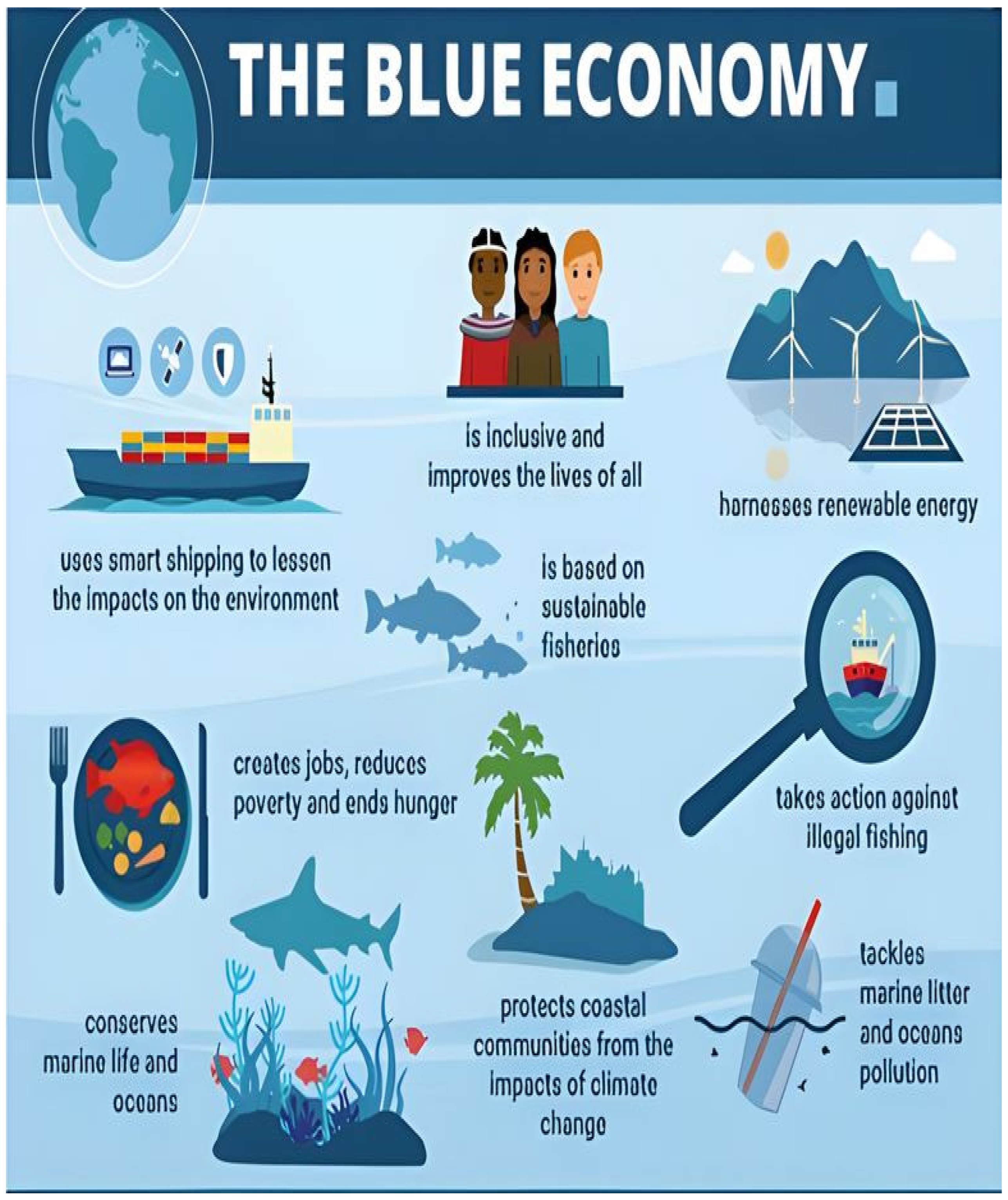
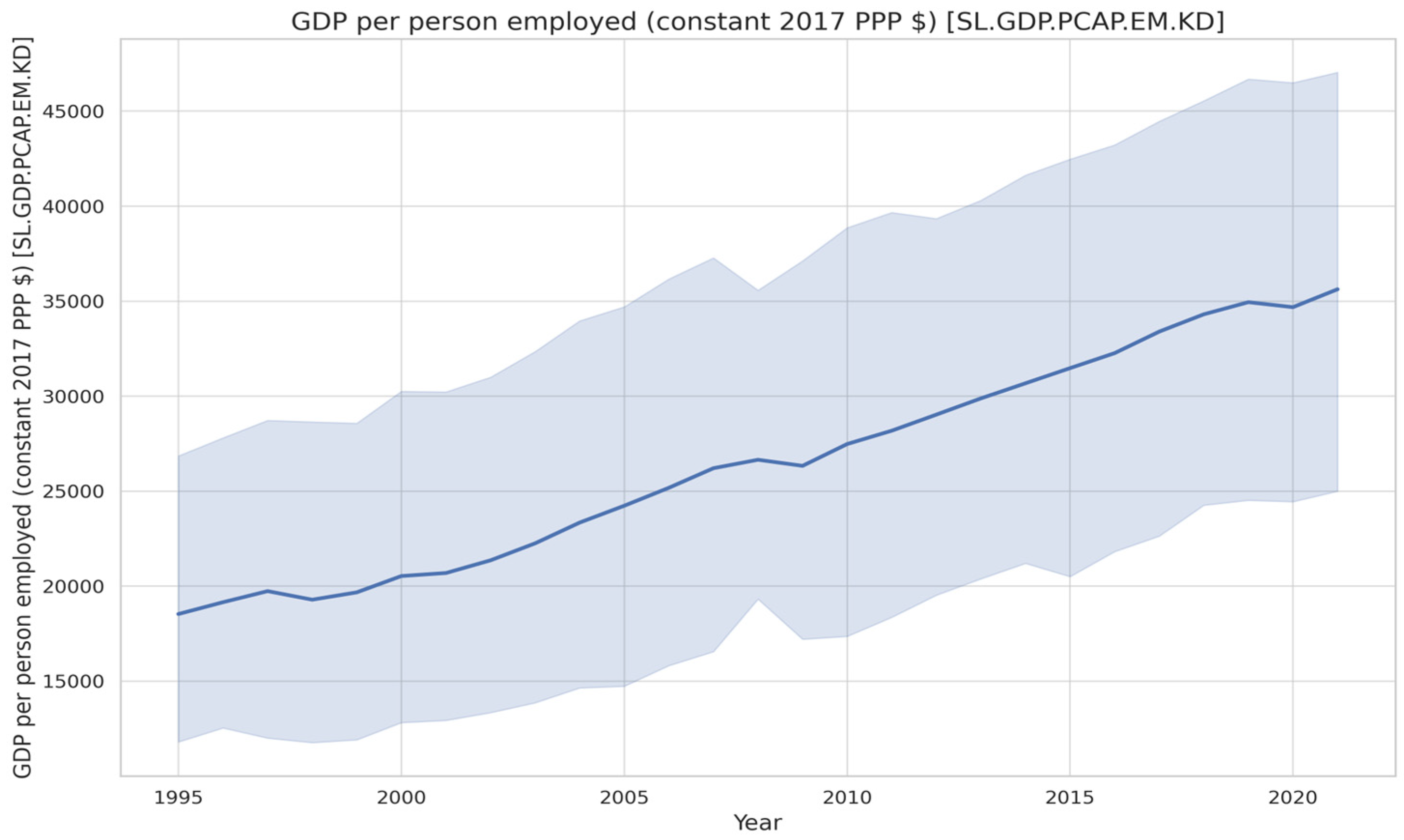
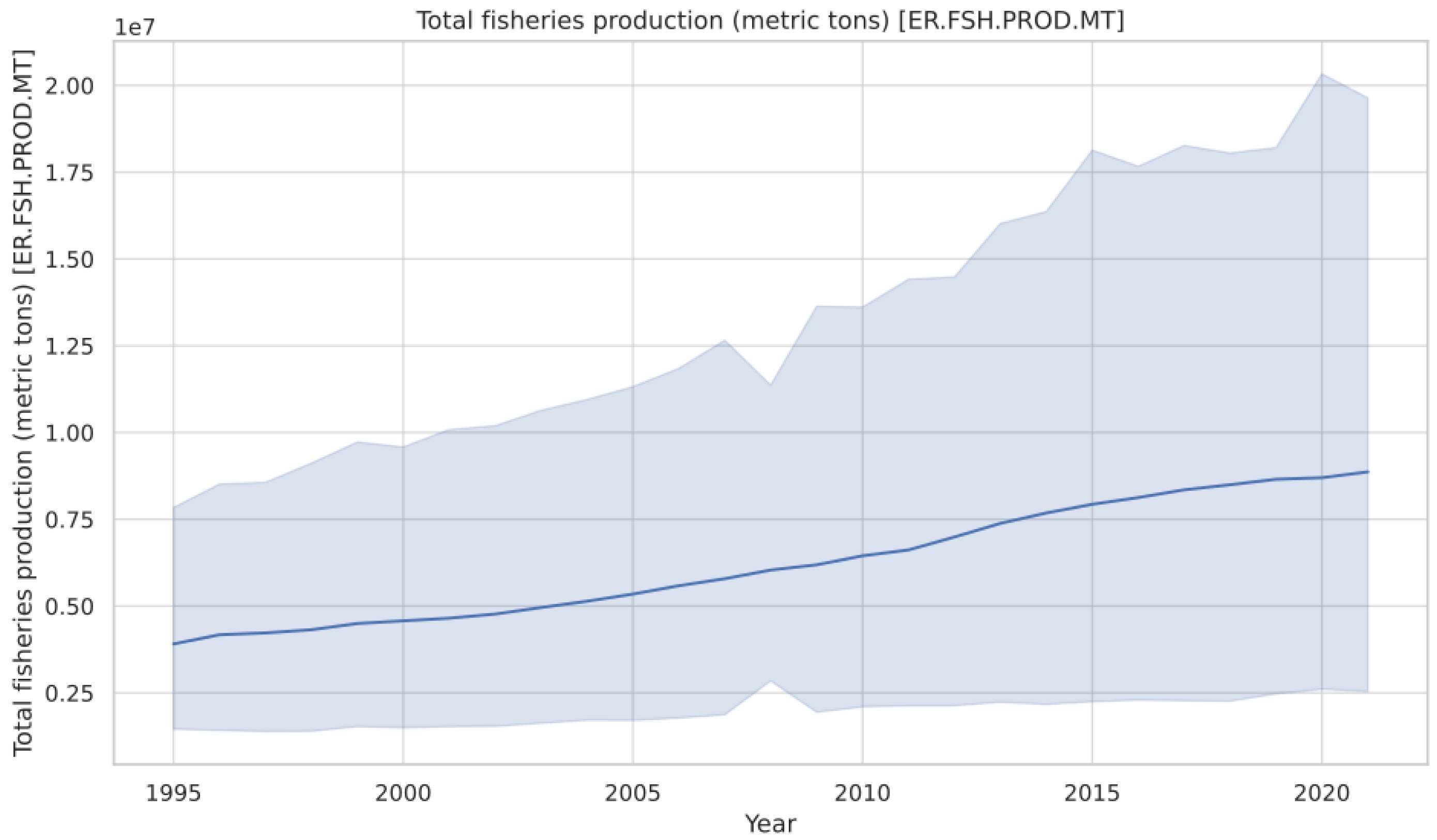
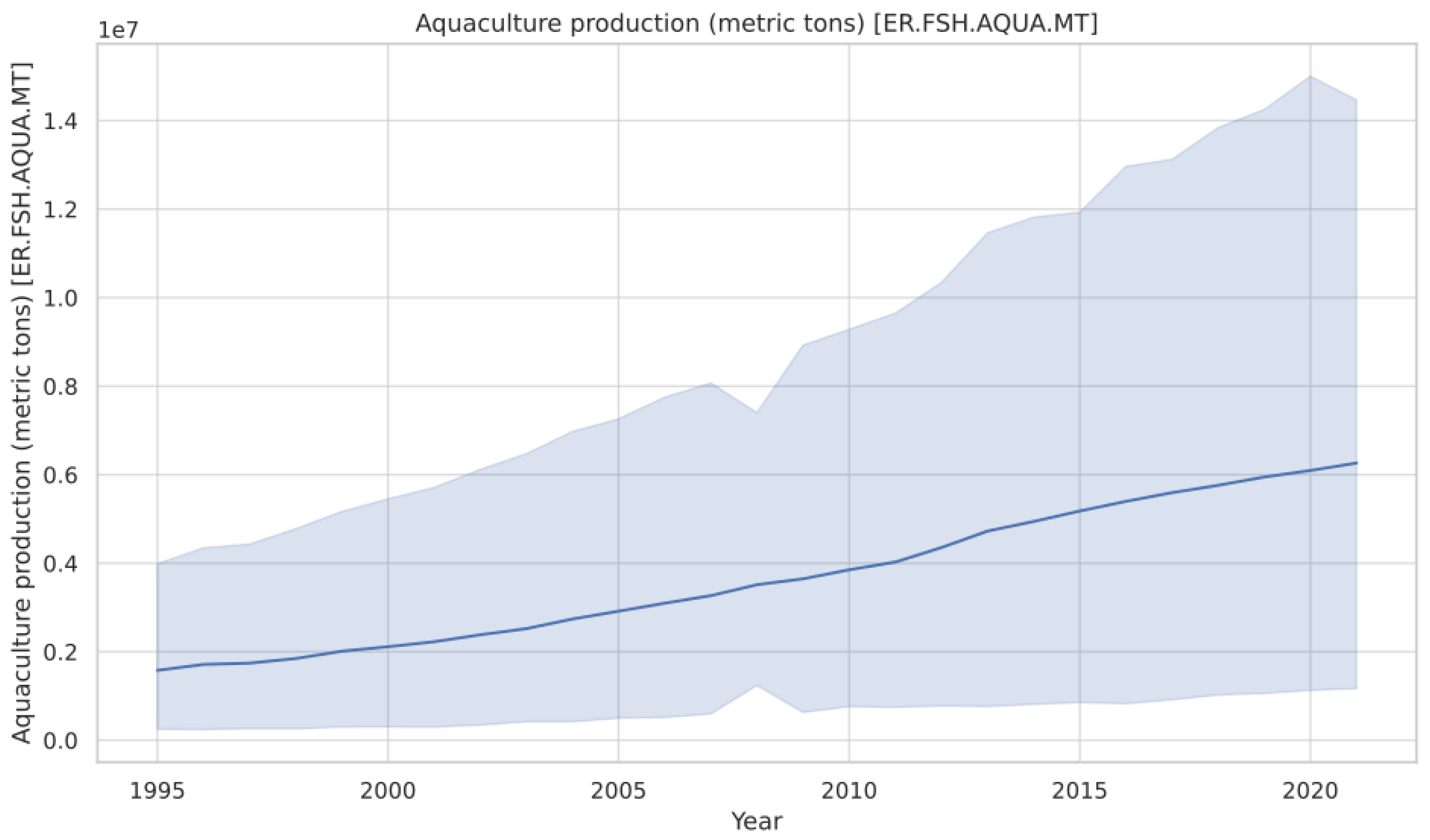
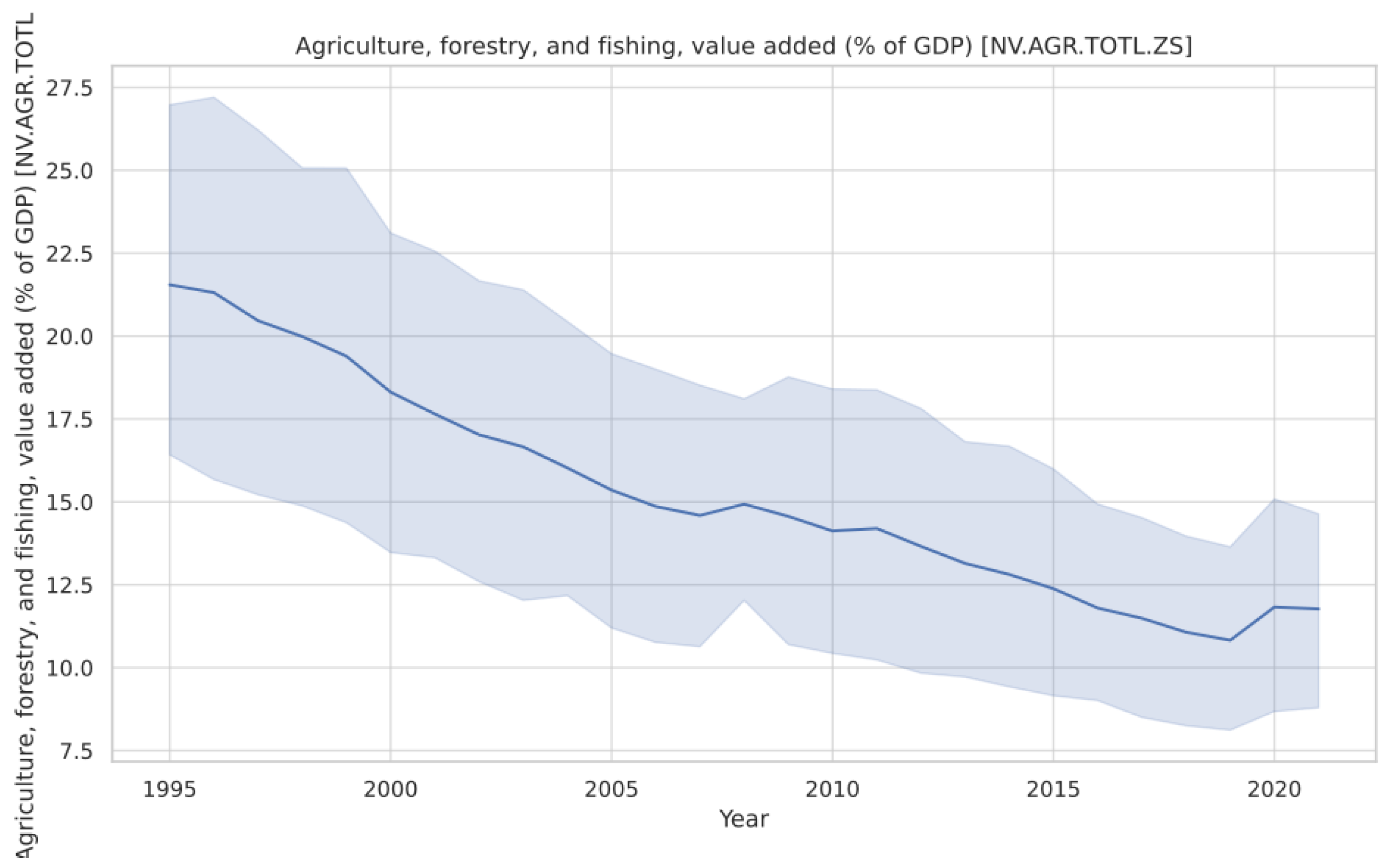
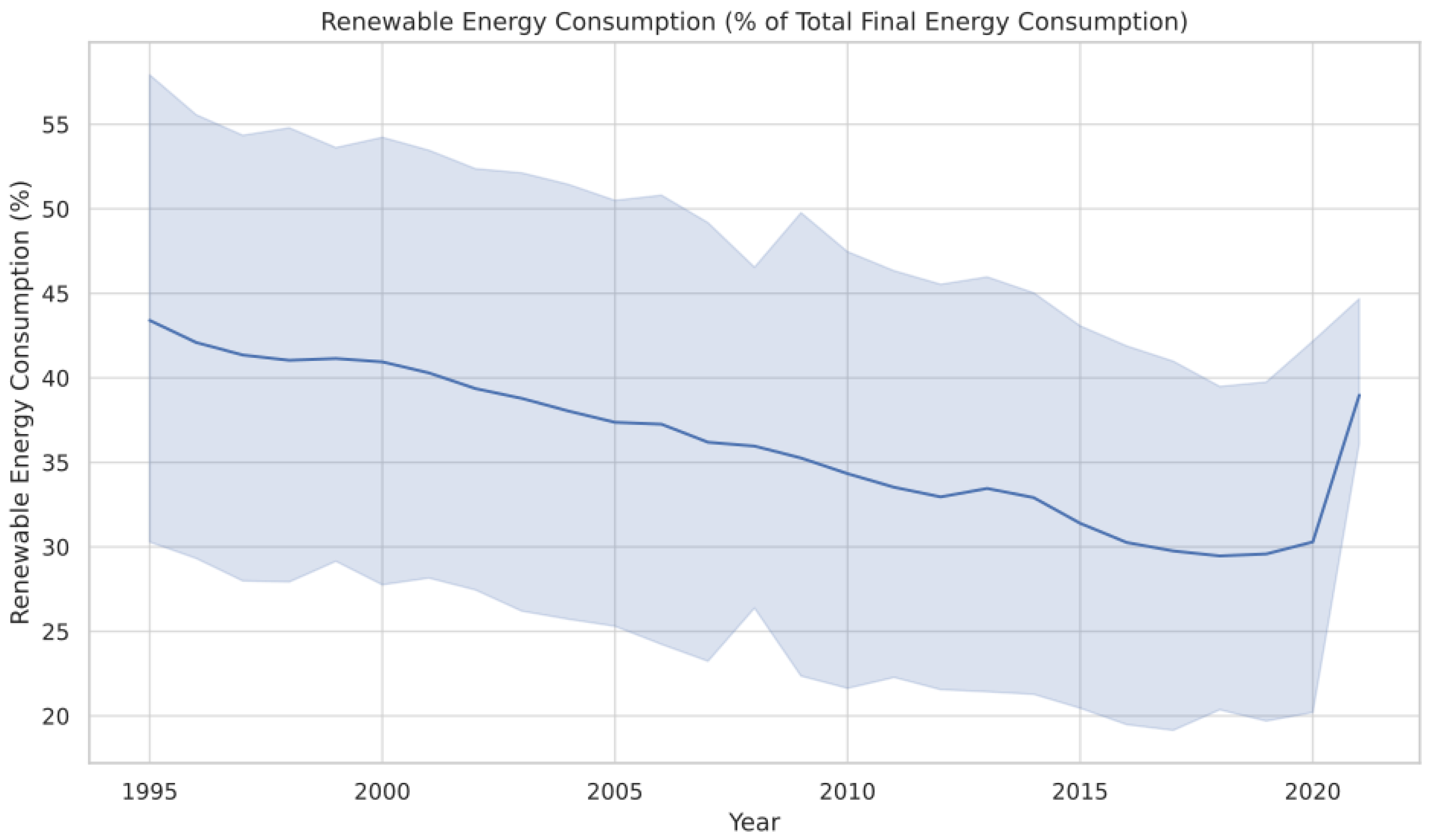
| Author(s) | Variables | Methodology | Findings |
|---|---|---|---|
| [45] | Inclusive growth | Mixed methods | The agricultural industry in Myanmar has a lot of untapped potential for promoting fair economic growth, but it requires targeted investments, better infrastructure, and long-term planning to address productivity issues and properly use its competitive advantages. |
| [46] | Fishery production | Field Surveys | A multidisciplinary approach was used to classify 20 different fishery production systems into 10 different groups based on ecological, economic, social, technological, and political factors, showing the complexity of artisanal fishing in the area and providing useful information for customized management and development strategies. |
| [47] | Fishery production system | Grouping Analysis | The “RAPFISH” methodology was used to evaluate 20 fishery production systems off the coast of Pará, Brazil, and three main groups were identified: industrial and semi-industrial fisheries that show economic and social sustainability, large-scale artisanal fisheries that show ecological sustainability, and small-scale artisanal fisheries. Some of the recommendations are reducing industrial fishing activities, implementing licensing quotas, funding research for semi-industrial and large-scale artisanal fisheries, offering financial incentives for small-scale artisanal fisheries, and encouraging stakeholder involvement in decision making. |
| [48] | Inclusive growth | Content analysis | While a consensus definition of inclusive growth is still hard to find, it is clear from a review of ADB’s well-founded knowledge products that it is generally understood to mean “growth with equal opportunities”, including economic, social, and institutional aspects. Major suggestions emphasize the need for interdisciplinary strategies, such as encouraging sustainable economic growth, guaranteeing fair political involvement, and supporting social safety nets and capacity-building initiatives to promote inclusive growth and development. |
| [49] | Aquaculture production | Case studies | The research emphasizes that while compartmentalization offers a promising strategy for disease management, its successful implementation in aquaculture depends on aligning with the specific production system and disease epidemiology, implying that it may not be universally applicable, and underscores the importance of integrating HACCP principles for effective biosecurity in compartmentalized systems. Moreover, the study explores the valuable role of compartmentalization in addressing and managing aquaculture disease emergencies. |
| [50] | Agriculture, forestry, and fishing | Case studies, SLR | The study indicates that worker protection in the agriculture, forestry, and fishing (AgFF) sector is considerably limited, with regulatory protections weaker than in other industrial sectors and enforcement being insufficient. The vulnerability of AgFF workers is aggravated by immigration policies, and the sector’s workforce has historically experienced legal “exceptionalism,” resulting in the exclusion of many regulatory protections specifically designed to secure workers in other industries. |
| [51] | Capital–labor | Mathematical analysis | The study confirms the presence of a unique marginal rate of technological substitution under optimal capital–labor conditions and establishes a practical procedure for finding the optimal capital–labor ratio in any two-factor production function, grounded in microeconomic theory, where the marginal rate of technological substitution is set to one unit, relying on an accurate representation of key enterprise dynamics. |
| [52] | Trade openness | New endogenous growth model | The study introduces a novel trade openness index and employs a multifaceted approach, revealing that while human and physical capital positively influence long-term economic growth in India, trade openness has a negative long-term impact, with short-term positive effects, and Granger causality tests support the existence of trade-openness-led and human-capital-led growth hypotheses. |
| [53] | Ecological footprint | Statistical analysis | The study presents a methodological framework for calculating ecological footprints associated with leisure tourism in the Seychelles, highlighting the environmental impact of air travel, and raises important questions about the potential role of long-distance travel in safeguarding biodiversity, emphasizing the need for sustainable tourism practices. |
| [54] | Renewable energy utilization | Systematic literature review (SLR) | The study provides a comprehensive overview of island energy resources, investigates the current utilization status and development potential of various renewable energy sources for island power grids, and presents advanced technologies and strategies to improve the penetration of renewables, highlighting the increasing importance of sustainable energy solutions for island communities. |
| Panel | Mean | Min | Max | Sd. Dev. | Source |
|---|---|---|---|---|---|
| Inclusive growth (ING) (GDP per person employed) | |||||
| LMYCs | 8.715 | 6.234 | 9.768 | 0.456 | W.D.I. |
| UMYCs | 11.865 | 9.245 | 12.564 | 0.501 | |
| HYCs | 12.545 | 11.231 | 13.453 | 0.392 | |
| Total fishery production (TFP) (metric tonnes) | |||||
| LMYCs | 4.134204 | 1.80672 | 4.615417 | 0.43924 | W.D.I. |
| UMYCs | 5.352802 | 2.649245 | 5.610105 | 0.356066 | |
| HYCs | 6.586513 | 4.445568 | 5.60746 | 0.026144 | |
| Aquaculture production (AP) (metric tonnes) | |||||
| LMYCs | 2.6166512 | −10.94238 | 3.78219 | 1.261692 | W.D.I. |
| UMYCs | 1.169859 | −6.25558 | 4.29876 | 1.237899 | |
| HYCs | 0.9107528 | −7.198535 | 6.107207 | 1.59848 | |
| Trade openness (TOP) (% of GDP) | |||||
| LMYCs | 99.56 | 14.564 | 423.234 | 65.563 | W.D.I. |
| UMYCs | 76.754 | 13.522 | 218.543 | 34.677 | |
| HYCs | 73.234 | 0.154 | 178.354 | 33.453 | |
| Agriculture, forestry, and fishing (AFF) (% of GDP) | |||||
| LMYCs | 1.322114 | −3.963077 | 9.169629 | 1.40004 | W.D.I. |
| UMYCs | 2.24804 | −3.962927 | 7.510115 | 1.55605 | |
| HYCs | 1.282795 | −4.012442 | 4.854778 | 1.386042 | |
| Total ecological footprint (EF) (global hectares per capita) | |||||
| LMYCs | 1.603 | −0.823 | 3.421 | 0.664 | W.D.I. |
| UMYCs | 2.312 | −1.065 | 3.546 | 0.654 | |
| HYCs | 2.543 | −0.234 | 3.213 | 0.590 | |
| Renewable energy utilization (RE) (% of total final energy use) | |||||
| LMYCs | 16.751 | 0.000 | 82.654 | 16.152 | W.D.I. |
| UMYCs | 25.687 | 1.263 | 86.045 | 18.432 | |
| HYCs | 44.673 | 0.015 | 92.661 | 28.654 | |
| Problem | Test | Lower Middle | Upper Middle | High Income | |||
|---|---|---|---|---|---|---|---|
| Test.stat | Prob. | Test.stat. | Prob. | Test.stat. | Prob. | ||
| Cross S.D | Breusch and Pagan LM | 1254 *** | 0.00 | 873.6 *** | 0.000 | 2264 *** | 0.000 |
| Pesaran LM adj | 19.94 *** | 0.000 | 18.33 *** | 0.000 | 54.58 *** | 0.000 | |
| Pesaran CD | 6.107 *** | 0.000 | 8.127 *** | 0.000 | 12.52 *** | 0.000 | |
| Slope heterogeneity | ∆ | 23.671 *** | 0.000 | 26.940 *** | 0.000 | 24.025 *** | 0.000 |
| ∆^ adj | 28.449 *** | 0.000 | 32.378 *** | 0.000 | 31.37 *** | 0.000 | |
| Heteroscedasticity | Modified Wald Breusch–Pagan/Cook–Weisberg Wooldridge | 21,889.68 * 14.06 *** | 0.000 0.000 | 11,466.28 * 7.55 *** | 0.000 0.000 | 32,884.53 * 44.82 *** | 0.000 0.000 |
| Autocorrelation | 228.93 *** | 0.000 | 12.786 *** | 0.000 | 208.76 *** | 0.000 | |
| Variables | Lower Middle | Upper Middle | High Income |
|---|---|---|---|
| At level (intercept and trend) | |||
| lnIG | −2.074 | −2.699 ** | −2.466 |
| lnTFP | −3.166 *** | −1.813 | −2.998 *** |
| lnAP | −3.616 *** | −3.777 *** | −3.870 *** |
| lnTOP | −2.782 *** | −2.332 | −2.051 |
| lnAFP | −1.998 | −1.988 | −2.164 |
| LNEF | −3.063 *** | −2.552 | −3.457 *** |
| LNRE | −2.156 *** | 2.899 | 2.443 ** |
| At first difference (only with intercept) | |||
| lnIG | −3.522 *** | −3.817 *** | −4.047 *** |
| lnTFP | −4.818 *** | −3.426 *** | −3.787 *** |
| lnAP | −5.286 *** | −5.595 *** | −5.726 *** |
| lnTOP | −4.365 *** | −4.094 *** | −3.775 *** |
| lnAFP | −4.239 *** | −3.968 *** | −4.504 *** |
| LNEF | −3.22 *** | 3.456 *** | 3.111 *** |
| LNRE | −4.165 *** | −3.707 *** | −3.251 *** |
| Panel | Variance Ratio | |
|---|---|---|
| Statis. | Prob. | |
| LMYCs | 3.485 ** | 0.0005 |
| UMYCs | 4.283 *** | 0.0000 |
| HYCs | 4.223 *** | 0.0000 |
| Variable | Lower Middle | Upper Middle | High Income | ||||||
|---|---|---|---|---|---|---|---|---|---|
| Coff. | Std. Er. | Prob. | Coff. | Std. Er. | Prob. | Coff. | Std. Er. | Prob. | |
| lnIG | −0.535 *** | 0.055 | 0.000 | 0.682 *** | 0.053 | 0.000 | 0.736 *** | 0.689 | 0.001 |
| lnTFP | 0.077 ** | 0.015 | 0.059 | 0.099 | 0.006 ** | 0.086 | −0.015 | 0.004 | 0.128 |
| lnAP | 0.232 *** | 0.031 | 0.000 | 0.053 ** | 0.033 | 0.055 | 0.222 *** | 0.041 | 0.008 |
| lnTOP | 0.345 *** | 0.090 | 0.006 | 0.544 *** | 0.248 | 0.000 | 2.296 *** | 0.083 | 0.002 |
| lnAFP | 0.788 ** | 0.004 | 0.080 | −0.889 ** | 0.009 | 0.017 | 0.023 *** | 0.011 | 0.007 |
| LnRE | −0.345 *** | 0.005 | 0.030 | −0.576 *** | 0.003 | 0.012 | 0.896 *** | 0.010 | 0.005 |
| F-Stat | 177.44 *** (0.000) | 134.29 *** (0.000) | 81.89 *** (0.000) | ||||||
| R2 | 0.566 | 0.678 | 0.360 | ||||||
Disclaimer/Publisher’s Note: The statements, opinions and data contained in all publications are solely those of the individual author(s) and contributor(s) and not of MDPI and/or the editor(s). MDPI and/or the editor(s) disclaim responsibility for any injury to people or property resulting from any ideas, methods, instructions or products referred to in the content. |
© 2024 by the authors. Licensee MDPI, Basel, Switzerland. This article is an open access article distributed under the terms and conditions of the Creative Commons Attribution (CC BY) license (https://creativecommons.org/licenses/by/4.0/).
Share and Cite
Geng, B.; Wu, D.; Zhang, C.; Xie, W.; Mahmood, M.A.; Ali, Q. How Can the Blue Economy Contribute to Inclusive Growth and Ecosystem Resources in Asia? A Comparative Analysis. Sustainability 2024, 16, 429. https://doi.org/10.3390/su16010429
Geng B, Wu D, Zhang C, Xie W, Mahmood MA, Ali Q. How Can the Blue Economy Contribute to Inclusive Growth and Ecosystem Resources in Asia? A Comparative Analysis. Sustainability. 2024; 16(1):429. https://doi.org/10.3390/su16010429
Chicago/Turabian StyleGeng, Biao, Daoning Wu, Chengshu Zhang, Wenbao Xie, Muhammad Aamir Mahmood, and Qamar Ali. 2024. "How Can the Blue Economy Contribute to Inclusive Growth and Ecosystem Resources in Asia? A Comparative Analysis" Sustainability 16, no. 1: 429. https://doi.org/10.3390/su16010429





